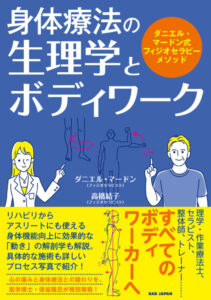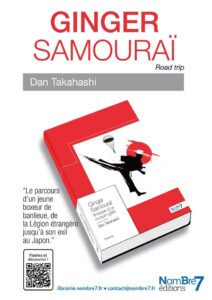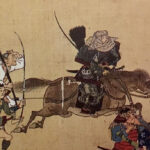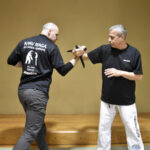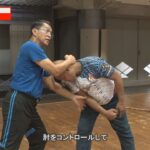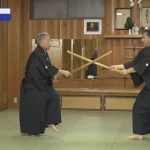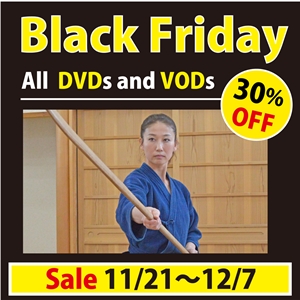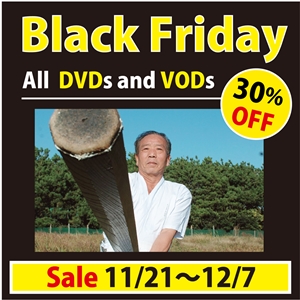【Exploring the spirit of the Ryukyu】Special edition (HIDEN July 2025)「Homage to CHINEN SENSEI」
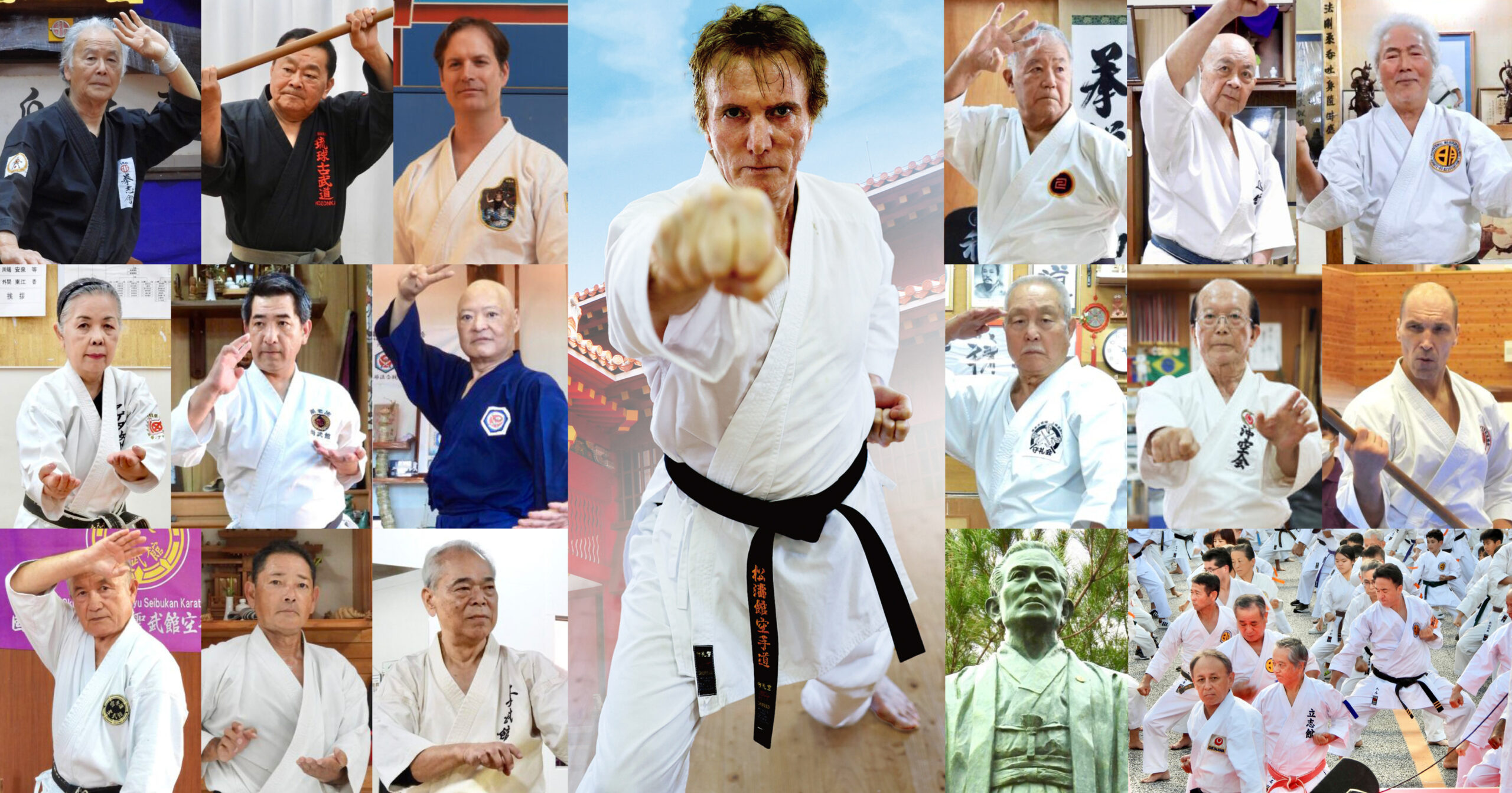
Interview/Writer: Daniel Mardon
Photographer/Translator: Yuko Takahashi
Daniel Mardon, “The karateka-therapist
Physiotherapist and longtime martial-arts practitioner, Daniel Sensei lives in Okinawa. One of his passions is to find unique Dojo with strong personalities that will leave an imprint forever. With his wife Yuko Takahashi, who is a great Karate historian, they let us discover many hidden aspects of Okinawa Karate…
This special series of articles proposes to explore the original spirit of Karate. Today, the subject is:
Homage to Chinen Sensei; a life spent to spread Okinawa Karate in France and abroad.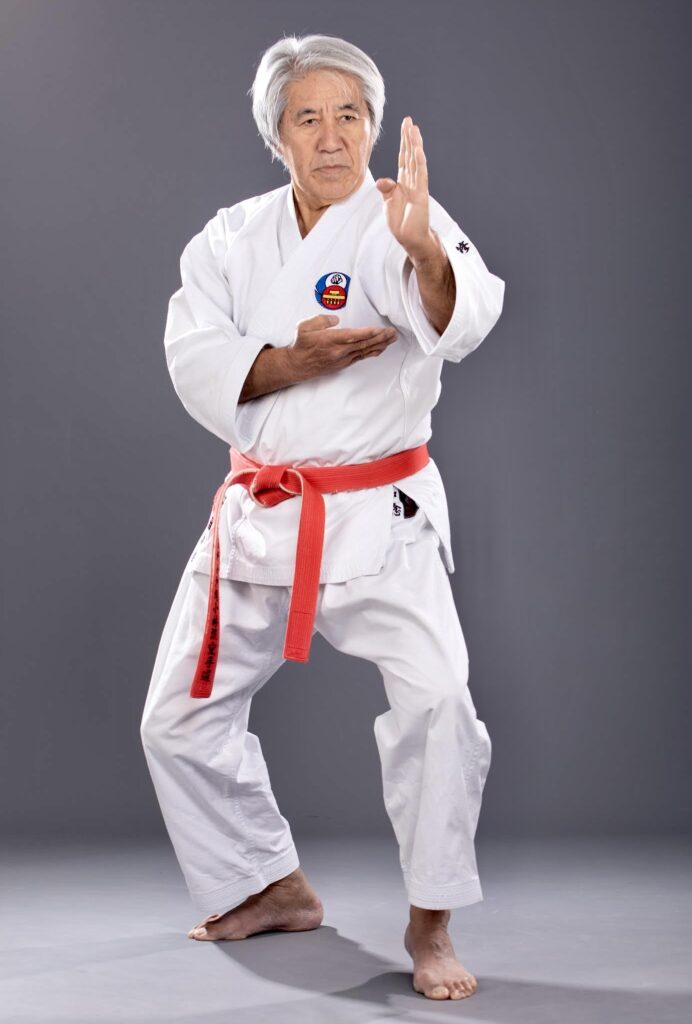

Chinen Kenyu Sensei.
Introduction
Master Chinen Kenyu (1944-2024), 10th dan of both Shorin-Ryu Karate and Kobudo, left us recently at the age of 80. He leaves behind teachings rich in techniques and philosophy with the Oshukai school…
Born on the small island of Iejima, northwest of Okinawa (5km from Motobu port) he was a student of Master Nakazato Shugoro for Karate and Matayoshi Shimpo for Kobudo. At the age of 31, he realized his wish to spread the culture of Okinawa abroad and especially to teach his Karate there.
The young Master knows that Okinawa Karate is already very present in the West and particularly in the Americas due to the large Okinawan diaspora in Brazil, Peru, Hawaii and the important turn over of GIs from Okinawa. That is why he decides to choose another continent. It will be in Europe since its location is between the West and the Far East and France because Paris represents the central point between these two extreme poles of Karate.
It was in 1976 that Chinen Sensei landed in Paris with one suitcase, no contacts and without any knowledge of the language. After a difficult start during which he was mostly perceived as a Kobudo specialist, he finally got recognized as a Karate teacher in a country that mostly works with Japanese Mainland Karate…
After several years, in 1985, he created the Oshukai association for which he was the director. Due to his human qualities and his great method of teaching, many Karatekas from Europe, Canada, Argentina, Chile and India joined his school which quickly became international. This is how the “World Oshukai Federation” was created in 1993 to which he was the President until his recent death. Today, the federation represents 15 countries with nearly 3400 practitioners. Recently, Sueyoshi Mikio Sensei was elected as the new President. Master Chinen is forever known as the founder of the W.O.F.
It is important to say that among the French Shotokan Karateka from that time, a few who, unlike me, had the chance to meet him, rallied to his side. Among them, one of his most faithful disciples from the first hour has become the President of Oshukai France and is also sitting today as the Vice-President of the W.O.F. His name is Maurice Roggero and he is a 9th Dan W.O.F.
Oshukai France is doing quite well, having a third of the world’s members and 39 Dojos on its territory… Among the many memories and anecdotes that Maurice Roggero Sensei keeps of his Shisho, he recalls that he was a very positive person that always moved forward, constantly seeking the effectiveness of his techniques. A simple man, always kind to his students, knowing them well because he always listened to them. This did not prevent him from separating from those whose ego had taken over too much.
His goal was to help his students to evolve through Karate, both technically and personally. Practicing Karate is meaningless, according to Master Chinen, if it does not have positive repercussions in our lives, at home, at school, or at work.
Roggero Sensei adds: “To strengthen our physical and mental abilities, he taught us the basic principles of Okinawan Karate, which are “Kyu-Do” (Search for the Way), “Tan-Ren” (Hard Work), and Cho-Wa (Harmony). He made us understand that to be a good and an effective fighter, we must not skip the steps. We must first work on the Kihon (basics), then the Kata, then the bunkai, then the 応用 Oyo (applications), the 約束組手 “Yakusoku Kumite” (codified attacks/defenses), and finally comes the Kumite…
This is the whole difference with Sport Karate, which generally focuses on Kumite, emphasizing the physical aspects and adopting a “special favorite strike”.
Like many other great Karatekas, Master Chinen also had other talents…. He was an artist and created many beautiful paintings. An exhibition was dedicated to him in Naha just a few months ago.
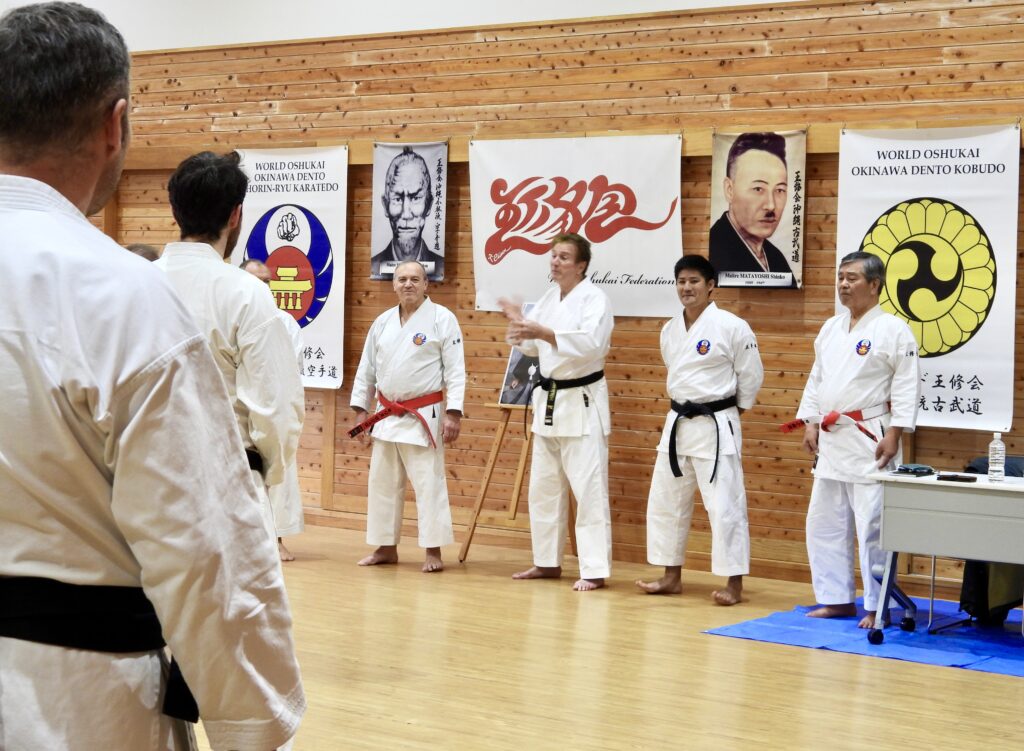
Greetings speech.

“Karate-Kaikan” Dojo with the W.O.F. logos.
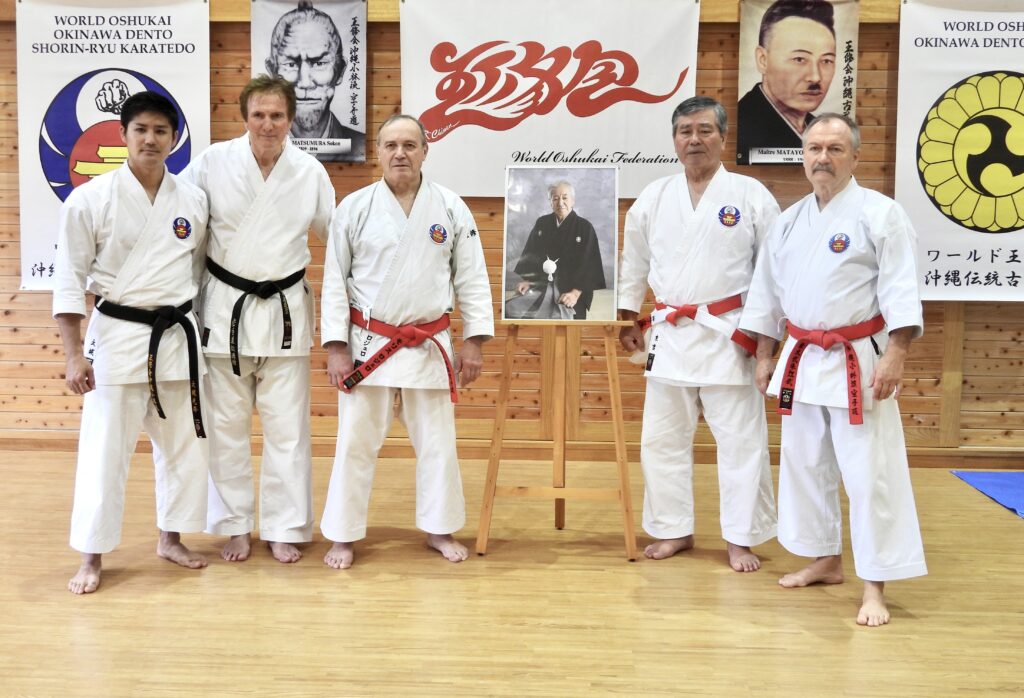
With the 4 main Masters. From left to right : Oshiro Kohei (General Secretary), Maurice Roggero (Vice-President), Sueyoshi Mikio (President) and Aleksander Staniszew (Vice-President).
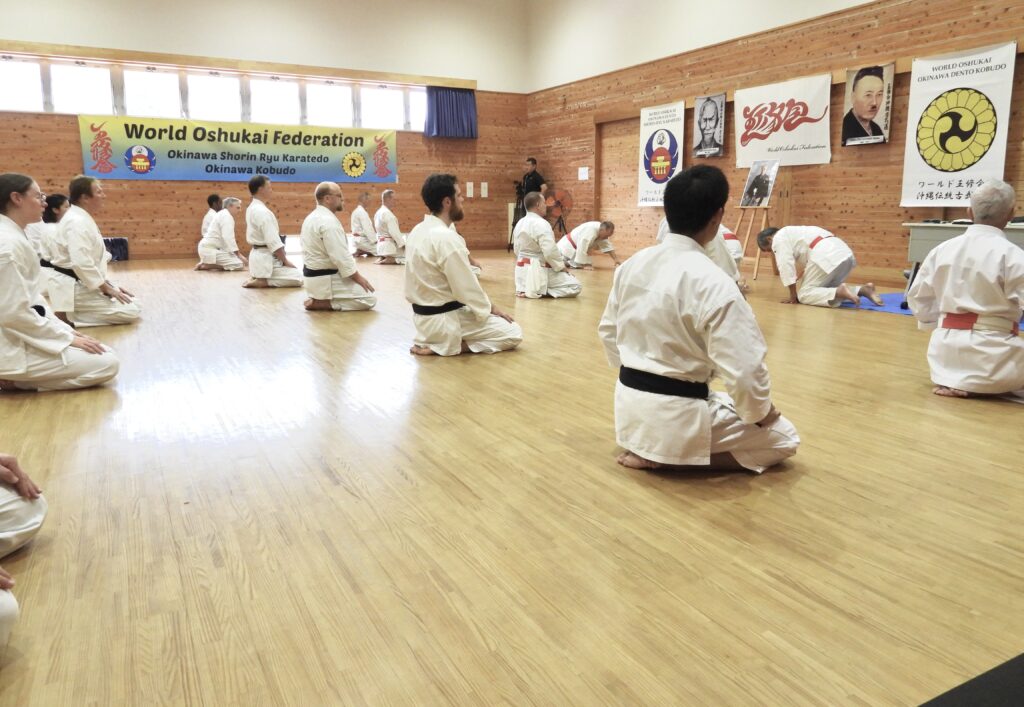
Formal Seiza opening and closing.
Oshukai arrives for a seminar at the sources
My Do-Gi just comes out from the laundry after the recent training with the “Mission De Défense Française” led by Uema Takeshi Sensei and Major Gérald, when my Tokyo editor asks me to cover another event… It is a training course lasting several days involving the W.O.F. (World Oshukai Federation) whose headquarters are in Okinawa, but which is very well represented in Europe and particularly in France, since its founder Chinen Kenyu Sensei lived there for nearly 50 years.
Having left France more than 30 years ago, I have no idea what French Okinawan Karate can represent, since it lived hidden and in the shadow of the all-powerful and unique French Karate Federation…. I have information that the delegation, mainly French, is led by two great figures of European Shorin-Ryu and Kobudo, both being disciples of the same level of Chinen Sensei. They are Master Maurice Roggero and his Polish counterpart Aleksander Staniszew.
D-Day
Having undergone a minor surgery on my jawbone a few hours earlier, I arrived early in the morning at the Karate Kaikan loaded with antibiotics and painkillers.
People carrying gym bags enter the building, smiling at us because they recognize the couple Yuko Takahashi and I, who are feeding them regularly with Okinawa Karate stories…. We will have to try again to be up to the task!
One of the Karate Kaikan Dojos has been specially decorated with the different logos of the Oshukai World Federation. We are introduced to its new President, Sueyoshi Mikio Sensei, as well as to Vice-Presidents Maurice Roggero and Aleksander Staniszew, who are also, respectively, the Presidents of Oshukai France and Oshukai Poland.
I immediately see a great deal of kindness and humility in the eyes of these three men who invited me to take part of the class. The warm-up and first part will be led by Master Staniszew and it begins with a long seiza and bows with Moku-So, Shomen-Ni-Rei, Otagaï-Ni-Rei.
[NOTE: Although some international Dojos practice formal bows, this is not a standard in Okinawa, especially in smaller Dojos. This often surprises some Western or Japanese Karatekas. While respect and bowing are of course required, bows on the knees are mostly given when entering and leaving the training area, especially for children. Basically, each Sensei applies his own rules for his own Dojo and there are no standards. Among the different forms of bows that are unique to certain Dojos, please refer to previous articles such as those about Higa Minoru Sensei’s Kyudokan (https://budojapan.com/karate/dm11e/) or the Yūsenkan Moidi Motobu-Ryu of my late friend Yagi Isao Sensei (https://budojapan.com/karate/dm06e/)].
After a thorough warm-up, Staniszew Sensei leads the Kihon, Waza and different combinations of techniques that follow one another very quickly. Everyone seems familiarized with this routine except me! As always, I am struggling despite having been a black belt for over 45 years. This is what happens when you leave your comfort-zone and challenge something new, even if it is still Karate. Ego is suffering and your brain cannot keep up. Having practiced Karate at hundreds of Dojos on the 5 continents, I am used to it, but I have never had so much frustration as I have in Okinawa! I was hoping to have a great time when I learned that Maurice Roggero Sensei, along with the other elders of my generation, Gilles Mehard and Lucien Santos, are all coming from the same Shotokan Dojos I used to go…
I am discovering that Chinen’s Shorin-Kobayashi is not only different from Shimabukuro Zenpo’s Shorin-Sukunai (which I am starting to get used to), but is also different from Higa Minoru’s Kobayashi which is the closest I can find to my Shotokan!
Among the 3 varieties of Shorin-Ryu that are the “Sukunai” from Kyan Chotoku, the “Kobayashi” from Chibana Chōshin and the “Matsubayashi” from Nagamine Shoshin, variations seem to exist even within them!
Here, the Tsuki is quite confusing for me, because they are using the 斜拳 “Shaken”! I had learned that this famous diagonal fist inherited from Kyan Chotoku is normally the mark of the “Seibukan”; the Sukunai Dojo from Shimabukuro Zenpo’s family…? Moreover, the Shaken-Tsuki here is not aiming at the median line like in Sukunai & Shotokan, but parallel to the midline in front of the shoulder! This alignment constitutes the characteristic of Chibana Chōshin’s Kobayashi, but without the fist in pronation as it should be…
It’s not easy to navigate all these nuances that are the pride and uniqueness of each Dojo.
To better understand, let’s talk about makiwara work. In the “Chibana Chōshin-Kobayashi”, a slight shift from the target is required, so that the arm can extend in a straight line from the shoulder. Same for “Chinen’s-Kobayashi”, except that here the fist arrives in a diagonal “Sukunai Shaken”…
We can therefore conclude that Chinen Sensei’s Tsuki comes from the heritage of both teachings from Kyan Chotoku and Chibana Chōshin…
The blocking techniques look like those of Shotokan, but also very much like those of Naha-Te with open hands and grips. The Kote Kitae and hardening sessions are similar to what I know from Goju-Ryu and in fact, all Okinawan Ryu. They all share a similar method and spirit, even if the techniques differ to a greater or lesser extent. This is why Shorin-ryu, from which Japanese Shotokan originates, can seem so far in its essence…
I share this feeling with Maurice Roggero Sensei who is about to teach the second part. He comes to my aid by slowing down a bit the pace and telling me that my main problem is that I am still using the too low Shotokan stances. I must forget the Kōkutsu (後屈), which doesn’t exist here, and the long Zenkutsu (前屈)…
On the other hand, I rediscovered, for the first time in 13 years of practice in Okinawa, the Yoko-geri and the Ushiro-geri! Very hard to do for me today, they used to be my specialty, making me score in competitions. Roggero Sensei also corrects my Mawashi-geri, which, in the Oshukai school, is done like a Mae-geri with a final circular hip sway.
I sincerely thank Sensei Roggero and Staniszew for being so patient with me and for putting up with my frustration which was sometimes accompanied by a few cuss words that could have been mistaken for Kiai…
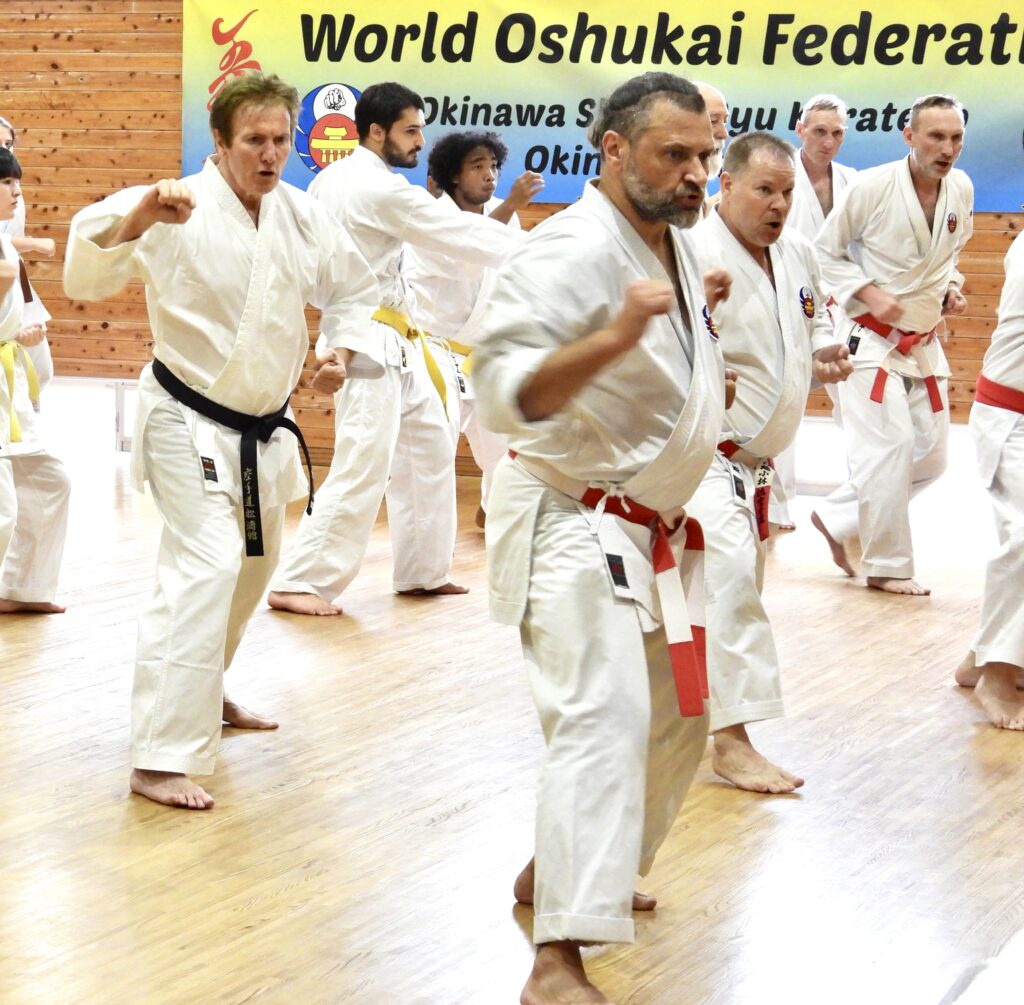

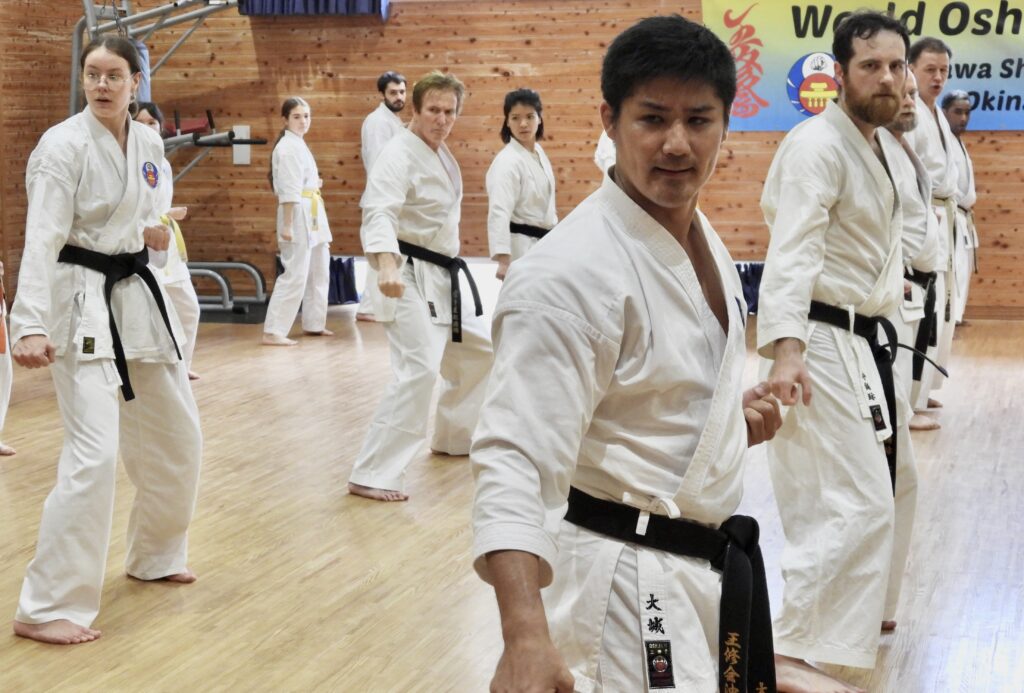
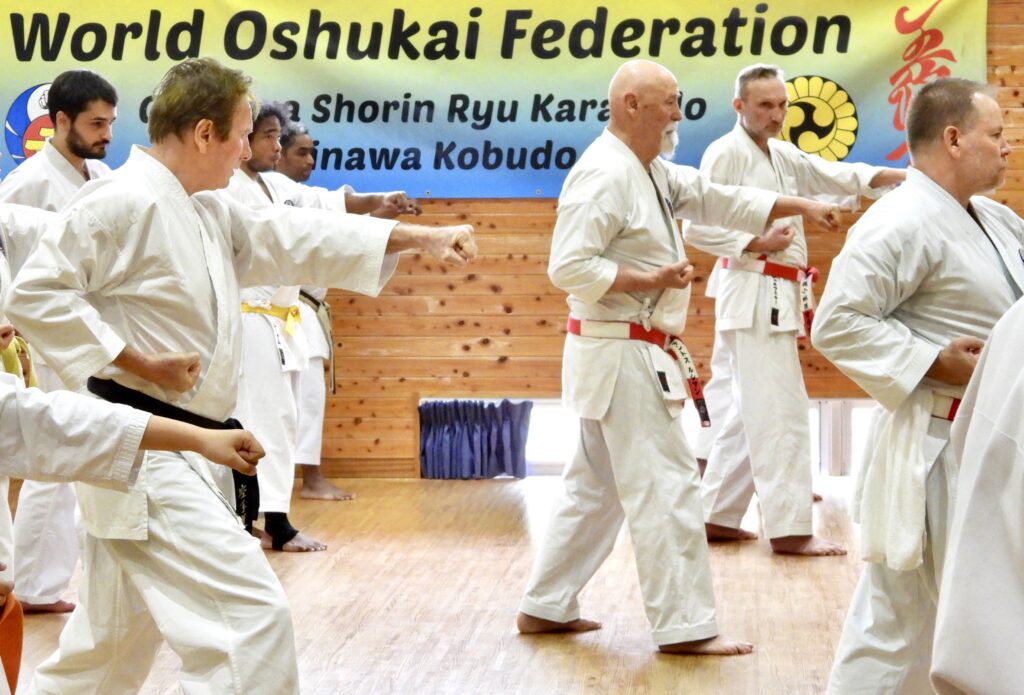

Succession of Kihon with multiple repetitions.
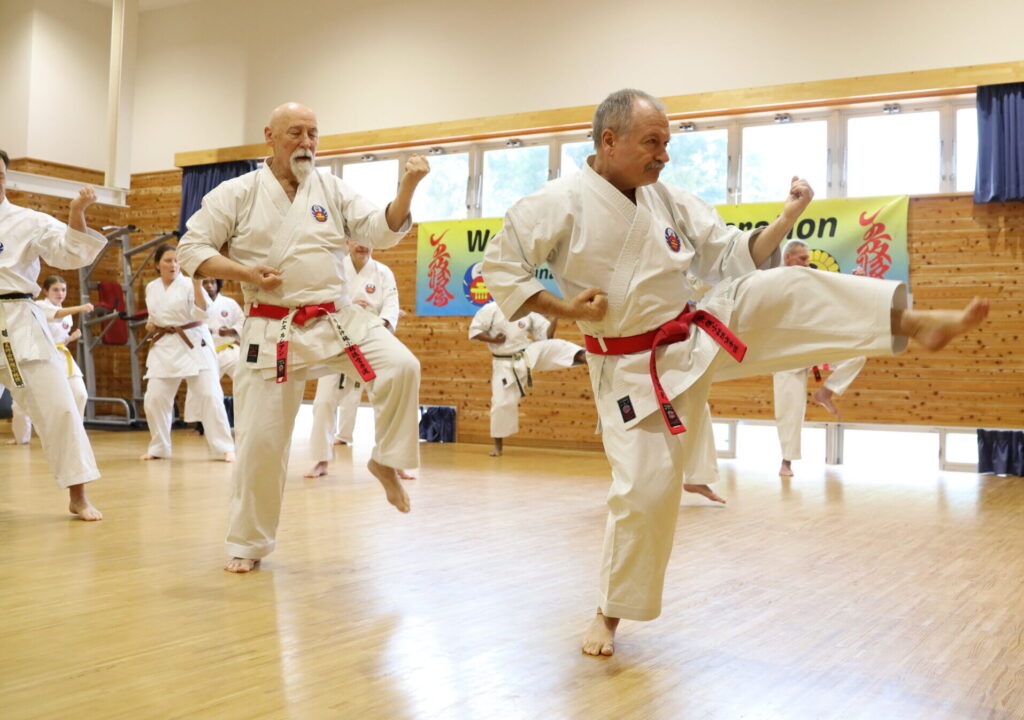
Kihon Keri by Staniszew Sensei.

Staniszew Sensei demonstrates the subtlety of effortless blocks.
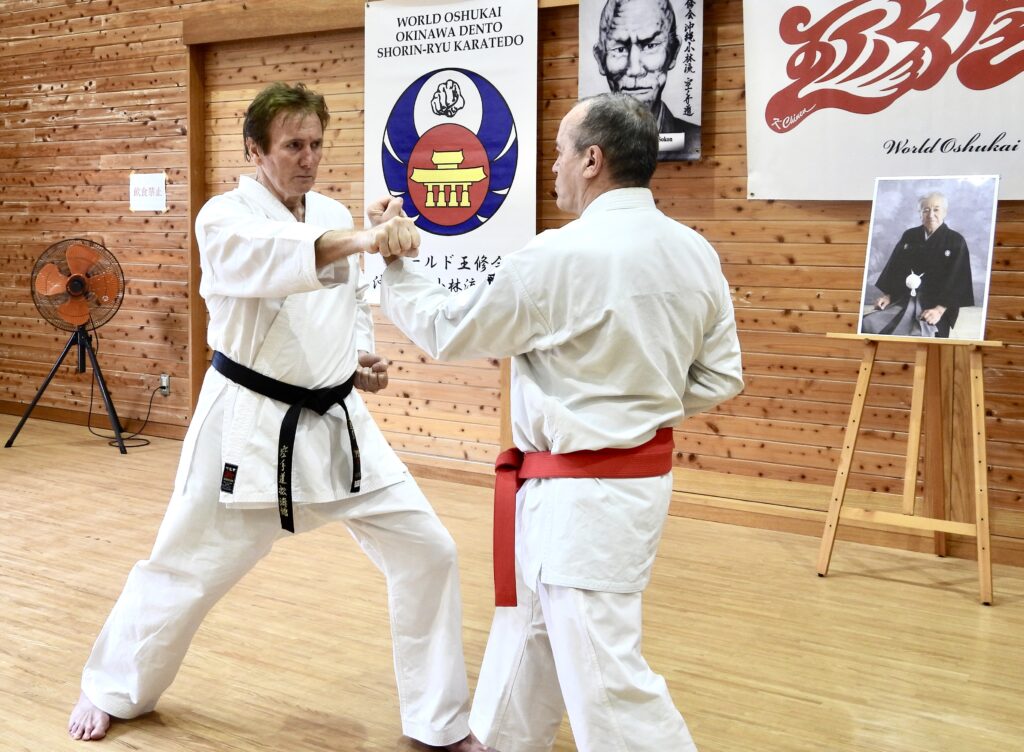

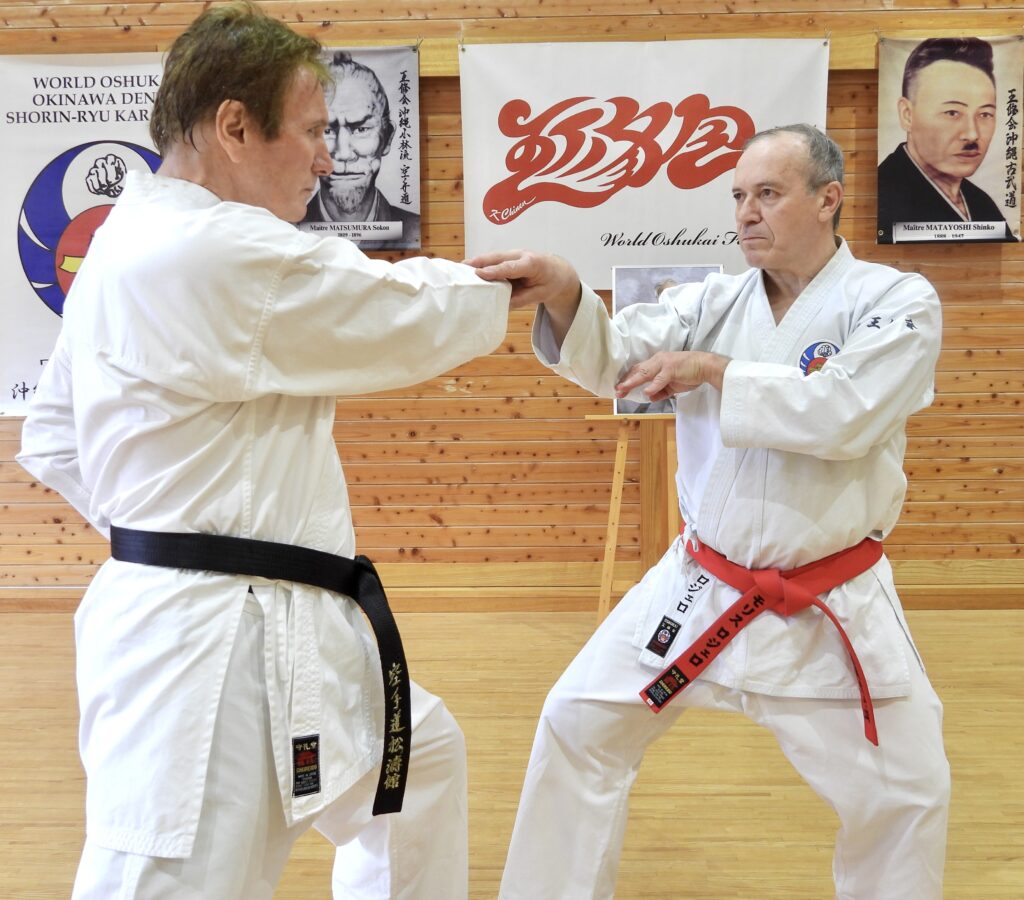

Roggero Sensei explaining the different approaches to block or to parry a tsuki.
A word from Chinen Sensei’s disciples
President Sueyoshi and the two Vice-Presidents, Roggero and Staniszew, will conduct the mission to faithfully preserve Master Chinen’s teachings, which represent the philosophy of Okinawa Karate.
The work practiced in the Dojos must remain the same, based on the application for combat techniques. 50% must represents the repetition of techniques with Ki-hon, Waza, Kata and 50% with contact-practice including Kata-Bunkai (disassembly), Yakusoku (codified Kumite), Kote-Kitae (Body-parts strengthening), and Jiyu-Kumite (free-style combat). A sense of family and cohesion must be maintained through ongoing exchanges within the Federation (courses, meetings, and celebrations). Chinen Sensei used to travel regularly to many countries to lead courses and the same must be done.
This is why a relation of trust and recognition was established from the beginning.
With these concepts linked to the constant search for efficiency, Master Chinen taught many techniques that can be adapted to the practitioner’s body shape. This explains the reasons for his great success abroad on different morphologies.
Roggero Sensei explains how he met his Master
– “It was in 1976, during a Kobudo seminar. This discipline was almost unknown and very difficult to access at the time. Knowing that I was a Karateka, he showed me Shorin-Ryu techniques in the evening after the training course. These had nothing to do with my Shotokan! My Karate was based on strength and blocks moving mostly backwards and here I was instructed to move in! Shotokan blocks are certainly effective, but I realized that they also delay counterattacks because of distances.
Being average built, I also experienced that against bigger and stronger fighters, I had difficulty to absorb and to block strikes while remaining in a Zenkutsu frontal position. Despite the communication problems, Sensei put all his efforts into making me understand with precise gestures. This new style was a revelation for me.
In 1980, after talking to my former teacher for whom I had great respect, I decided to change my style. Shotokan Karate had become less attractive and limited for me. Its focus on physical strength with all the physiological problems that it could eventually cause discouraged me. Moreover, French Shotokan was becoming a sport all about competition and which no longer had anything to do with traditional Karate.”
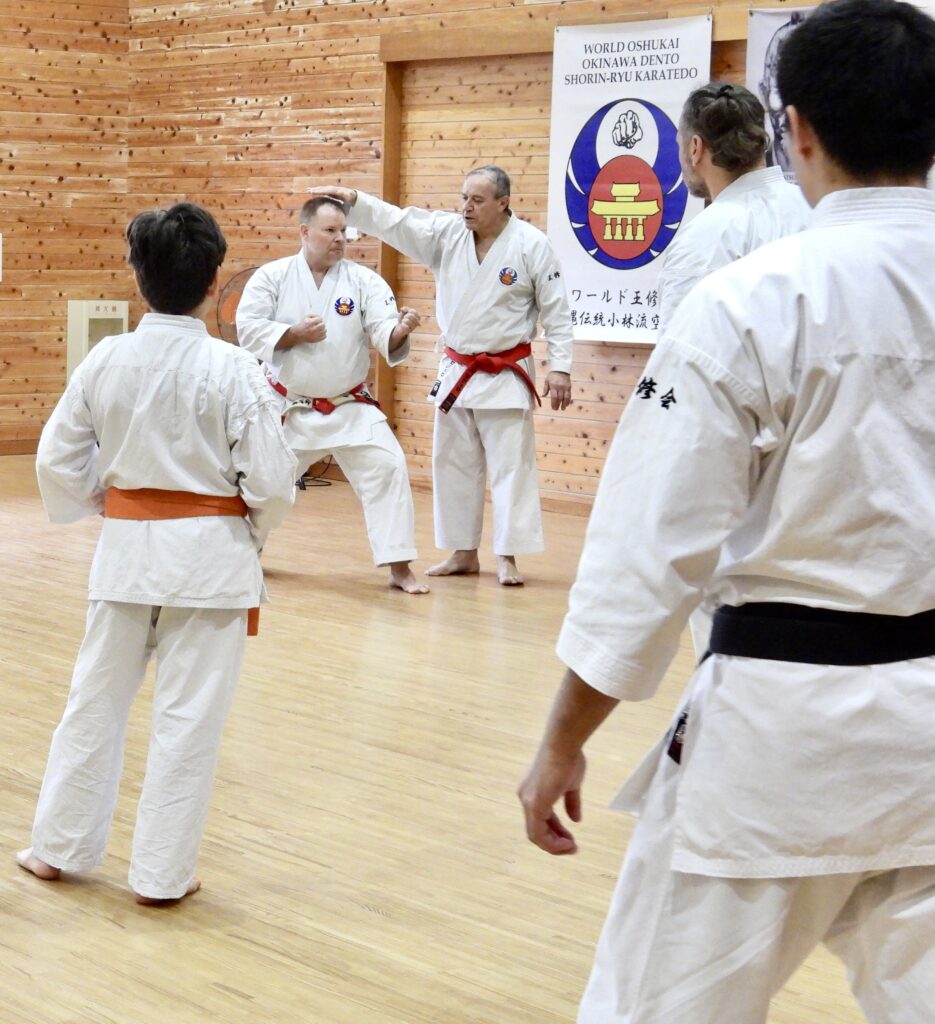
I recognize here, Kase Taiji Sensei’s teachings, when he was telling us to imagine training under a low ceiling.



Low-kicks at close range are OK.
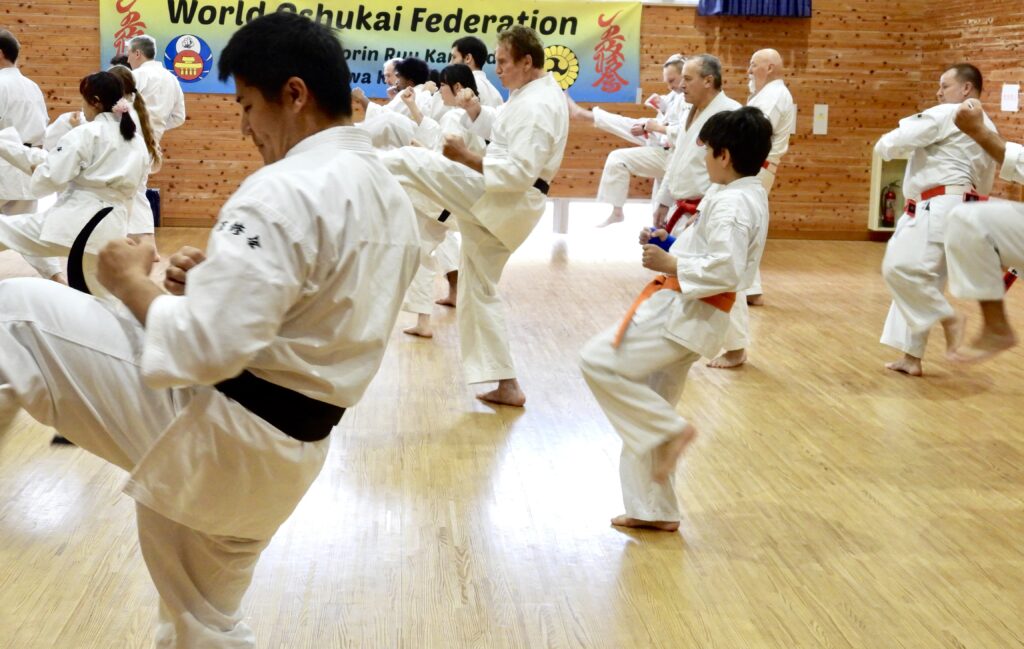

Variation of Keri going back and forth.
Conclusion with metaphysical considerations and my biomechanical analysis.
Yuko Takahashi Sensei and I agree that this seminar was very interesting, because it was 100% led by occidental teachers, which was a first for us.
Although the techniques and method were in the pure Okinawa tradition, I could still feel a little flair of Europe with the teachers and it felt like I was meeting old Karate friends who had evolved in a parallel Japanese universe.
In fact, that’s exactly what happened! Chinen Sensei allowed an Okinawan oasis to exist in France, then elsewhere, and allowed thousands of people to practice Karate without living at its source.
Although Shorin-Ryu remains quite rigid, as is Karate in general compared to kickboxing, it is still more fluid than Japanese Karate, with much higher and shorter stances. Here, speed, timing, and agility contrast with the heavy and violent explosions we have in Shotokan. We feel that this style can be practiced by many, because it requires less strength.
I have always kept my practice of Karate and kick-boxing separated because they are so different, nevertheless it seems that Shorin-Ryu could bring them together by offering the best of both. If I have never been able to abandon Shotokan, it is due to the “qualities of its faults”. It is an extremely demanding and physical Karate with the most impressive Katas… Its main problem is its very questionable biomechanics which damages the hip joints in particular.
In Okinawan styles, defensive blocks are executed while pivoting backwards (from the front foot) and offensive blocks, while moving in (by stepping from the back foot)… Blocking is usually done in a Shiko-dachi or a Fudo-Dachi stance. The hips are “open” in external rotations. This allows the counterattack to be performed powerfully, hips “closed” (in internal rotations) with a better reach, exactly like in boxing.
This is achieved perfectly when you have mastered the “Gamaku”.
I often speak about this magic name that constitutes the abdominal belt (abs, obliques, iliopsoas, lower back muscles). The Gamaku is indeed the master part that controls the orientation of the torso which initiates the shifts of the center of gravity. Then, the hip-joint rotations combined with a proper pelvic-tilt allow good positioning to ensure that the movement or the technique is done correctly. This synergy represents the “egg of Christopher Columbus” for good biomechanics.
The Shotokan that I was taught did quite the opposite. Indeed, our blocks are generally done without a real pivot and our feet are solidly anchored facing the opponent in Zenkutsu.
This can be verified in the Katas and the “Zenkutsu frontal position” expression used by Roggero Sensei above!
The 45 degrees rotation of the torso used to parry the attack, is often associated with a poor understanding and mobilization of the “Gamaku”. It leads to an internal rotation of the hips in compression. This is particularly true for the coxo-femoral joint of the back leg. From this closed-hip-position, the counterattack can only be achieved with a powerful “opening” of the hips (external rotation)…! This has the consequence of overloading the hips and to create unnecessary compressions that violate the coxo-femoral cartilages which are quite fragile…
Moreover, the very low and strongly anchored positions of Shotokan constitute an aggravating factor! The extension of the back leg during a low Zenkutsu creates a twisting of the femoral head ligaments, causing inflammation of the soft-tissues. This phenomenon has been studied on the fencing practitioners who use similar lunges. Yet many teachers still today teach that everything must come from the hips…!
The notion of hard and flexible unfortunately does not exist in the Shotokan (that I have been taught) and this is probably why the great Master, Kanazawa Hirokazu, appreciated Tai Chi in his old days….
As most Okinawa styles do, Shorin-Ryu uses smooth and absorbent blocks, which reduces the necessity for power between fighters. The techniques can therefore compensate for a lack of physical strength, allowing smaller sizes to successfully perform..
I am sometimes asked why I continue to practice Shotokan since I often criticize it…. As I already explained, this “love-hate relationship” seems to affect many elders of my generation who cannot deny that, apart from a few mechanical nonsenses, this Ryu possesses great values of balance, stability and power that others do not have. By digging into the history of Karate, we understand better… Although Funakoshi Sensei never had the profound medical knowledge of Miyagi Chōjun Sensei, he was nevertheless a brilliant man and is in no way responsible for the Japanese adaptation that was made of his Shotokan.
It is certain that in order to teach basic notions of Karate to troops instead of a handful of students, it was necessary to mechanize the training method in the style of military exercises and weapons handling. This drill practice was done to the detriment of the fluidity that characterized the Karate of this great Master and was not made to be practiced over long periods!
It might be time to accept these facts and to recognize what should be recognized. Cherishing the positive heritage from our Masters of the past can be done while readjusting a Karate to the reality of anatomy and physiology.
Being a long-time expatriate myself, I have a lot of respect for Chinen Kenyu’s journey as a man. Spending most of your life in a totally different country and culture is a daily work on oneself. Having to wear the missionary outfit for a lifetime is a priesthood that few people in their social comfort at home can imagine.
Obviously, after leaving his mentors by the age of 31, we understand that he is the man to look up to, even if his Masters were big celebrities.
His work is therefore two fold! He will have won the heart of the world by successfully expatriating himself while creating his own Karate style…

Maurice Roggero is a very humble and friendly Sensei.

Old friends that have started before the French Karate Federation existed and was still under Judo. From left to right : Gilles Mehard (Committee Member W.O.F.), Daniel Mardon and Lucien Santos.

With a few members from several delegations including Poland, France, Canada and Okinawa.
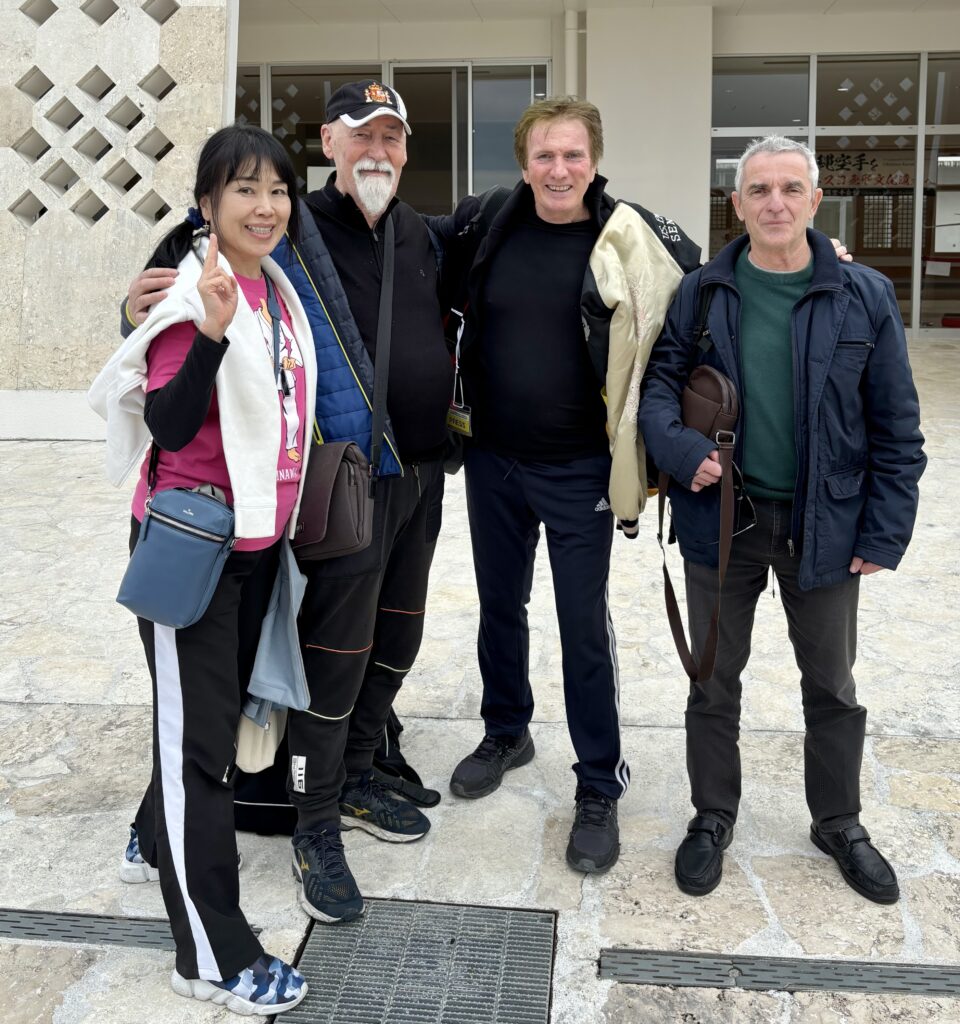
As always, big “Domo Arigato” to Yuko Takahashi Sensei! Without her, we couldn’t have this regular bridge from Okinawa and the entire world. (By the way, Takahashi means “High Bridge” in Japanese….)

Daniel Mardon; the Karateka-Therapist
Creator of Aromapressure® method and physiotherapist with a valid US license, Daniel Mardon was born in Paris. One of his specialties is to teach and to perform lymphedema and subcutaneous tissue-damage care, after radiotherapy for cancer patients at medical institutions and subcutaneous tissue-circulation stimulation before and after surgery.
He was also a therapist for two famous soccer teams in Paris. Since 2005, he has focused on producing top-class hotel spas in Japan, as well as physiotherapy education and awareness-raising activities for health care professionals. Author of several books, among his major publications includes “The Physiology and Bodywork of Physical Therapy ” (Published by BAB Japan) and DVD “Daniel Mardon Aromapressure® Method ” (Pony Canyon). He regularly appears on television and radio shows, and has featured in numerous media publications.

